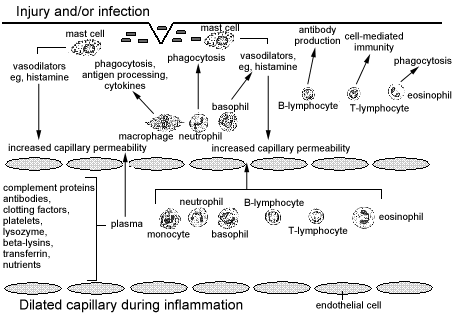Fig. 2: Tissue and a Blood Vessel
During Inflammation

Following infection or injury, mast
cells release vasodilators which increase capillary permeability allowing plasma
and leukocytes to leave the bloodstream and enter the tissue. Benefits are as
follows:
- Plasma entering the tissue delivering:
- Complement proteins = inflammation,
enhanced attachment, WBC chemotaxis, cell lysis
- Antibodies = opsonization,
cell lysis, neutralization of viruses and toxins, agglutination of microbes,
blocking microbial adherance, immobilization of microbes
- Clotting factors and platelets
= localization of infection, WBC chemotaxis, stoppage of bleeding
- Lysozyme = breaks down peptidoglycan
- Human-defensins = alter cytoplasmic
membranes
- Transferrin = traps iron
- Nutrients = feeds inflammed
tissue
- Leukocytes enter tissue delivering:
- neutrophils = phagocytosis,
enzymes to synthesize inflammation mediators
- eosinophils = phagocytosis,
moderation of inflammatory damage
- basophils = release histamine,
promote inflammation
- monocytes = become macrophages
= phagocytosis, process antigens, release cytokines
- B-lymphocytes = antibody
production
- T-lymphocytes = release cytokines,
become cytotoxic T-lymphocytes CTLs)
Illustration of Tissue and a Blood Vessel During Inflammation .jpg by Gary E. Kaiser, Ph.D.
Professor of Microbiology,
The Community College of Baltimore County, Catonsville Campus
This work is licensed under a Creative Commons Attribution 4.0 International License.
Based on a work at https://cwoer.ccbcmd.edu/science/microbiology/index_gos.html.

Last updated: August, 2019
Please send comments and inquiries to Dr.
Gary Kaiser

